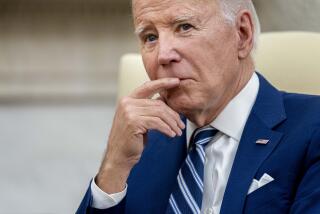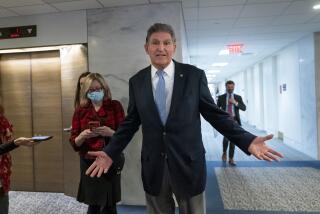A Tour Guide of Canada’s Major Political Parties
- Share via
Here are the five parties that are likely to be represented in Canada’s next government:
Bloc Quebecois
The Bloc came into being in 1990, when its leader, Lucien Bouchard, a former ambassador to Paris, jumped ship from the Progressive Conservative Party.
“I believe that we need to rethink this country,” he said in his letter of resignation. “We must stop trying to fit Quebec into a mold of a province like the others. . . .”
The Bloc is the single-issue party par excellence. To the extent that it has a platform on social and economic issues at all, the planks are laid out on the premise that most of Quebec’s problems stem from its association with English-speaking Canada.
The Bloc’s current mass support does not necessarily mean all Quebeckers are eager for a break with Canada. Quebeckers know that no matter how well the Bloc does in next week’s election, several other high hurdles would have to be cleared before the province could secede.
Reform Party
This started off as a movement of disgruntled western Canadian conservatives, who had helped send the Progressive Conservatives to Ottawa in 1984 and then discovered that the Tories seemed more preoccupied with Quebec’s demands than with the West. Even today, the party is particularly strong in Alberta.
The party stands for conservative economics--something new in Canada, where for at least three generations the entire political argument has been conducted on a ground noticeably to the left of that in the United States.
Reform voters are especially concerned about the country’s generous but costly social welfare programs. Party leader Preston Manning, the son of a former Alberta premier, would eliminate the federal deficit in three years by restructuring many of them.
A large part of Manning’s appeal in English-speaking Canada stems from his unwillingness to dicker with Quebec over the nature of confederation. His position is, essentially, Canada: Take it or leave it.
Progressive Conservatives
The Tories have governed Canada since 1984, and for most of that time their leader was Prime Minister Brian Mulroney, who managed to make himself the most unpopular Canadian prime minister in modern times.
Mulroney resigned last spring amid horrific poll results and ceaseless editorial batterings. After a party leadership race, Defense Minister Kim Campbell became prime minister in June.
The Progressive Conservatives are a mainstream conservative party, something like the Republicans in the United States but without the far-right twist of the Reagan wing.
They support international free trade and negotiated first a bilateral pact with the United States and then the North American Free Trade Agreement. They have also taken strides to reduce the Canadian budget deficit, but have not yet attacked core social programs.
Campbell is generally well liked in Canada, but she has been unable to put sufficient distance between herself and her terminally unpopular predecessor. Worse yet, she has ended up fighting an impossible, three-fronted war, with the Reform Party siphoning off votes to the right, the Liberals stealing the center, and the Bloc Quebecois mesmerizing Quebec.
Liberal Party
If the Progressive Conservatives are Canada’s Republicans, the Liberals are this country’s Democrats. In this fall’s election, they are promising to cut the fat in the federal budget, but at the same time to kick-start the economy with an old-time Keynsian program of public spending on infrastructure.
The Liberals are plagued by the same image problems as the Tories--they are an established party in an era of rebellion against traditional parties. But they are benefiting from a fear on the Canadian left and in the center of a Reform Party sweep.
Many Canadians who might otherwise have voted social democratic now plan to support the Liberals, just to rein in Reform. The Liberals are likeliest to come in first in this election--but it is unclear whether they will have a majority.
Perhaps the biggest problem for the Liberals is its leader Jean Chretien, a native-born, French-speaking Quebecker who served in the federalist Cabinet of ex-Prime Minister Pierre Trudeau. That means Quebec French-speakers see him as an Uncle Tom.
New Democratic Party
The New Democrats evolved out of Depression-era socialist currents on the Canadian prairies, and have long been Canada’s third-largest party at the federal level. At a provincial level, they now govern in Ontario, British Columbia and Saskatchewan.
In this fall’s election, however, they risk being wiped off the political map.
They stand for a set of West European social democratic principles that are considered passe in an era of shrinking resources. The party also wants to rescind the North American Free Trade Agreement.
Left-leaning Canadians have repeatedly told pollsters that they like leader Audrey McLaughlin’s personal style and her sensitivity on economic issues. But they say they fear that they will be wasting their votes on the party.
More to Read
Sign up for Essential California
The most important California stories and recommendations in your inbox every morning.
You may occasionally receive promotional content from the Los Angeles Times.










